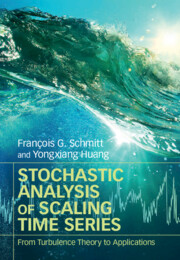Book contents
- Frontmatter
- Contents
- List of figures
- Preface
- 1 Introduction: a multiscale and turbulent-like world
- 2 Homogeneous turbulence and intermittency
- 3 Scaling and intermittent stochastic processes
- 4 New methodologies to deal with nonlinear and scaling time series
- 5 Applications: case studies in turbulence
- 6 Applications: case studies in ocean and atmospheric sciences
- References
- Index
Preface
Published online by Cambridge University Press: 05 December 2015
- Frontmatter
- Contents
- List of figures
- Preface
- 1 Introduction: a multiscale and turbulent-like world
- 2 Homogeneous turbulence and intermittency
- 3 Scaling and intermittent stochastic processes
- 4 New methodologies to deal with nonlinear and scaling time series
- 5 Applications: case studies in turbulence
- 6 Applications: case studies in ocean and atmospheric sciences
- References
- Index
Summary
Fluid geoscience, which includes the study of the atmosphere, the oceans, hydrology, and climate, is a special topic in science: it is the application, in some sense, of the Navier-Stokes and transport equations, as well as other fluid mechanics theoretical concepts, into the “dirty real-world”. In the theoretical realm and in the laboratory, where all conditions are controlled, a desired phenomenon can be isolated and studied. In the field, however, conditions are not controlled, leading to a multitude of mixed phenomena, and measurements are the result of a multiscale complex system. In such a system, stochastic fluctuations are often superposed onto deterministic forcing associated with astronomic cycles. Scaling concepts are very important when approaching and studying geophysical fields, but the stochastic scaling properties are perturbed by forcing of, say, the day-night cycle, the annual cycle, or the tidal cycle in oceanography. In such cases, scaling methodologies may fail. In this book, we shall discuss such issues, and provide new tools that are more adapted to retrieving stochastic scaling information from different turbulence and real-world situations.
Fluid geoscience is also a special topic, in the sense that it is extremely difficult to find adequate and solid theories. The underlying fundamental equations (e.g., Navier-Stokes) are nonlinear, and turbulence belongs to the last field of classical physics, which is still unsolved. The resolution of Navier-Stokes equations belongs to the Clay Institute's one-million-dollar problems. This explains why the field of fluid geosciences has only progressed, in some sense, so slowly. Nowadays, many models used are based on crude large-scale approximations of dynamics, based on averages of Navier-Stokes equations. These models are inaccurate and no theory really tackles the nonlinearities and intermittencies of the natural (fluid) turbulent-like world. New theories and new models are needed. The solution may reside in generalizations and continuations of Kolmogorov's seminal 1941 work, when a scaling law was proposed to describe velocity fluctuations at different scales. Multifractal models are continuations of these works from the 1940s, and their aim has been to find statistical laws (such as thermodynamics in statistical physics for an equilibrium system) able to describe and model, at different scales, the fluctuations of fields of interest.
Such a general objective explains why we have devoted the first chapters of this book to historical developments on scaling and multiscaling issues in the field of turbulence and passive scalar turbulent transport.
Information
- Type
- Chapter
- Information
- Stochastic Analysis of Scaling Time SeriesFrom Turbulence Theory to Applications, pp. xxiii - xxviPublisher: Cambridge University PressPrint publication year: 2016
